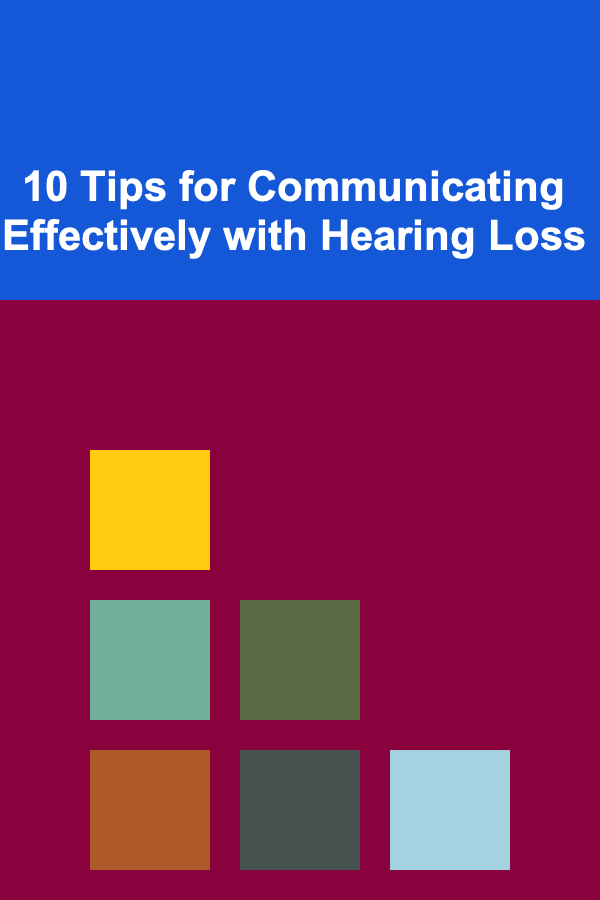
10 Tips for Communicating Effectively with Hearing Loss
ebook include PDF & Audio bundle (Micro Guide)
$12.99$8.99
Limited Time Offer! Order within the next:

Hearing loss is a condition that affects millions of people worldwide, and it can present unique challenges in communication. Whether you are experiencing mild, moderate, or profound hearing loss, effective communication is essential for maintaining relationships, work productivity, and overall well-being. The world around us often relies on verbal communication, but with a few adjustments, individuals with hearing loss can navigate conversations with confidence and ease.
In this article, we will explore 10 practical tips for communicating effectively with hearing loss. These strategies can help you enhance your interaction with others, whether at home, at work, or in social settings.
Be Honest and Open About Your Hearing Loss
The first step in effective communication is honesty. Let people know about your hearing loss as soon as possible. Many people with hearing loss avoid discussing it out of embarrassment or fear of being judged, but this only makes communication harder.
Why it matters:
When others are aware of your hearing loss, they can make accommodations and adjustments to help facilitate better conversations. By being open, you help others understand your needs and prevent potential frustrations or misunderstandings.
Example:
- When meeting someone new, simply say, "I have some hearing loss, so I may need you to speak a little more clearly or face me when you talk."
Use Visual Cues and Body Language
Hearing loss often means you miss out on verbal communication, but visual cues and body language can bridge that gap. When communicating, paying attention to non-verbal signals can be invaluable in understanding what's being said.
Why it matters:
Face-to-face communication provides more context through lip reading, facial expressions, and body language. People naturally use gestures and other visual indicators when speaking, so taking note of them can significantly improve your comprehension.
Example:
- In a conversation, look for hand gestures, eye contact, and even the person's posture to help you gather additional context.
Ask for Clarification When Necessary
If you don't understand something, don't be afraid to ask for clarification. Most people will be happy to repeat or rephrase themselves. In fact, asking for clarification demonstrates that you are engaged and invested in the conversation.
Why it matters:
When you ask for clarification, it helps prevent miscommunication, which can lead to frustration or mistakes. It also creates an opportunity for the speaker to adjust their communication style, making it easier for you to understand.
Example:
- "I didn't quite catch that. Could you please say it again, or maybe rephrase it for me?"
Position Yourself Strategically
In conversations, where you position yourself in relation to the speaker can significantly impact how well you can hear and understand them. If you have hearing loss, you may find it easier to hear people when they are directly in front of you, facing you.
Why it matters:
Many people with hearing loss rely on lip reading, facial expressions, and visual cues to assist with communication. Being in the optimal position ensures that these elements are easier to pick up on.
Example:
- Try to sit or stand in a place where you can see the person's face clearly, with good lighting on their face. Avoid sitting with your back to bright lights or windows, as shadows can make lip reading more difficult.
Use Assistive Listening Devices
Technological advances have made a variety of assistive listening devices available for individuals with hearing loss. From hearing aids to specialized apps and systems, there are many tools that can help improve communication.
Why it matters:
Assistive listening devices amplify sounds, reduce background noise, and improve clarity, making it easier for people with hearing loss to hear and understand speech.
Example:
- Hearing aids or cochlear implants can make everyday conversations more accessible, while technologies like FM systems can be helpful in noisy environments like classrooms or offices.
Maintain Clear and Effective Speech
When speaking to someone with hearing loss, make sure you speak clearly and at a moderate pace. Enunciate your words without exaggerating them, as overly slow speech can be as difficult to understand as speaking too quickly.
Why it matters:
Clear and effective speech helps the person with hearing loss interpret the message more easily, especially if they are relying on lip reading or visual cues.
Example:
- Avoid speaking with your mouth full or covering your mouth while speaking. This makes lip reading nearly impossible.
Avoid Multitasking During Conversations
Multitasking---such as speaking while eating, driving, or typing---can make communication much harder for someone with hearing loss. Try to minimize distractions and focus on the conversation at hand.
Why it matters:
When there are fewer distractions, it allows the person with hearing loss to concentrate better on the conversation. In noisy environments, distractions can exacerbate difficulties in hearing and understanding speech.
Example:
- If you're having a conversation, stop what you're doing and give the speaker your full attention. If possible, move to a quieter place for better communication.
Use Written Communication for Complex Topics
If you need to communicate a complicated or detailed message, consider using written communication. This can be especially helpful in work or medical settings where clarity is essential.
Why it matters:
Written communication allows the person with hearing loss to take their time in reviewing and understanding the information. This can help avoid misunderstandings that may occur in verbal communication.
Example:
- If you're discussing a technical topic, sending an email or providing a written summary can ensure that the key points are understood and retained.
Create a Comfortable Communication Environment
The physical environment plays a crucial role in how well people with hearing loss can understand speech. Creating an environment that is conducive to communication involves minimizing background noise and ensuring good lighting.
Why it matters:
Background noise can interfere with speech comprehension, and poor lighting makes it harder to lip-read and pick up visual cues. A quiet, well-lit environment creates the best conditions for clear communication.
Example:
- In a noisy restaurant, try to choose a quieter table, or consider using noise-cancelling headphones to block out ambient noise. At home, ensure that the lights are bright enough for lip reading.
Be Patient and Compassionate
Perhaps the most important tip is to practice patience and empathy. Hearing loss can be frustrating, both for the person with the condition and those communicating with them. Everyone involved in the conversation should make an effort to be patient and understanding.
Why it matters:
Patience fosters a positive environment where communication can flow smoothly. If mistakes are made or something isn't heard correctly, being compassionate and giving each other time to adjust helps maintain a supportive atmosphere.
Example:
- If a misunderstanding occurs, calmly address it and work together to find a solution. Being understanding helps reduce stress and makes communication more enjoyable for everyone involved.
Conclusion
Effective communication with hearing loss is entirely possible with a few adjustments, both on the part of the person with hearing loss and those around them. By being open about your hearing loss, using visual cues, maintaining clear speech, and leveraging assistive devices, you can improve your communication in a variety of settings. Remember that patience and understanding are key to creating an environment where everyone feels heard and valued.
With the right tools and strategies, individuals with hearing loss can lead fulfilling and communicative lives, maintaining strong relationships and a strong presence in both social and professional settings. By implementing these 10 tips, you can ensure that communication remains effective, inclusive, and stress-free for all parties involved.
Reading More From Our Other Websites
- [Organization Tip 101] How to Organize Your Kitchen Cabinets for Easy Access
- [Personal Care Tips 101] How to Select a Natural Antiperspirant for Sensitive Skin
- [Organization Tip 101] How to Clean and Maintain Your Wallpaper Removal Steamer
- [Personal Finance Management 101] How to Stay Informed with the Best Personal Finance Podcasts
- [Home Budget 101] How to Use Cash Envelopes to Stay on Track with Your Home Budget
- [Organization Tip 101] How to Choose the Best Day and Time for Your Yard Sale
- [Personal Investment 101] How to Protect Your Investments During Economic Downturns
- [Home Soundproofing 101] How to Evaluate Your Soundproofing Needs Based on Room Usage
- [Organization Tip 101] How to Use Labels to Enhance Volunteer Space Clarity
- [Home Rental Property 101] How to Handle Late Rent Payments and Late Fees

How to Maximize Profit from Your Home Rental Property
Read More
How to Set Up a Stylish Home Bar for Your Party
Read More
How To Understand Common Dog Health Issues
Read More
Studying Marine Protected Areas Effectiveness: A Comprehensive Guide
Read More
How to Get Started with Freelance Income
Read More
How to Become a Talent Agent: A Step-by-Step Guide
Read MoreOther Products

How to Maximize Profit from Your Home Rental Property
Read More
How to Set Up a Stylish Home Bar for Your Party
Read More
How To Understand Common Dog Health Issues
Read More
Studying Marine Protected Areas Effectiveness: A Comprehensive Guide
Read More
How to Get Started with Freelance Income
Read More